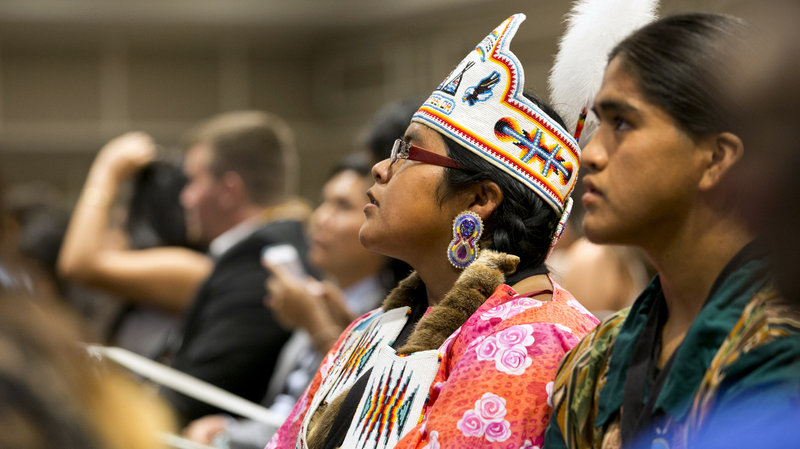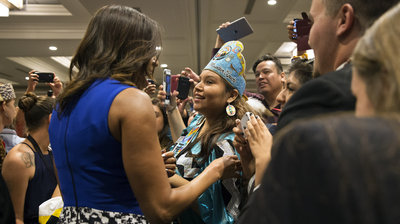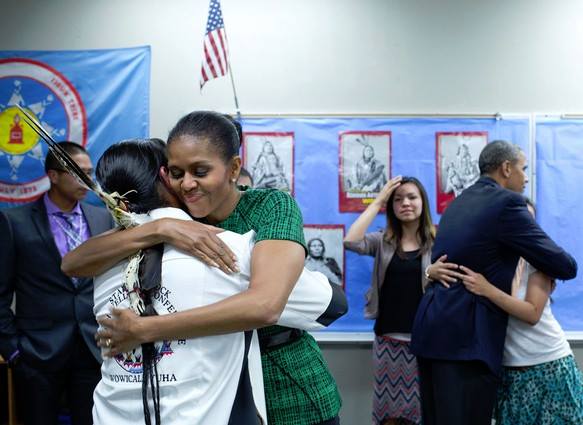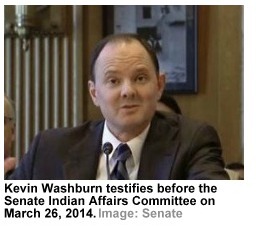By Rob Capriccioso, ICTMN
The week of September 9 was a big one for tribal visits to Washington, D.C.
There was a fancy shindig at Vice President Joe Biden’s house where Indian bigwigs including Jackie Johnson Pata, John Dossett, Terri Henry, Jodi Gillette and others celebrated the passage of the pro-tribal sovereignty Violence Against Women Act earlier this year. A meeting of the National Congress of American Indians (NCAI), focusing on the budget crisis, sequestration, and tax issues, saw dozens of tribal leaders express concerns. There were Indian health-focused meetings with the Department of Health and Human Services and the Office of Management and Budget. A Senate Committee on Indian Affairs hearing (sparsely attended by any senators) focused on water rights issues facing several tribes.
Tribal leaders used their time in Capital City to lobby federal officials for protection of the federal-tribal trust relationship, while trying to stave off budget cuts, enhance tribal sovereignty, and get more federal dollars flagged for reservation economic development.
Congress members, while sympathetic to the cause, couldn’t help but see dollar signs. Ever worried about winning the next election cycle, legislators from both sides of the aisle were quick to hit up tribal leaders for big bucks.
On the Republican side, Rep. Tom Cole (R-OK) hosted a breakfast for his good friend Rep. Mike Simpson (R-ID) September 12 at the exclusive Capitol Hill Club. The event was publicized and promoted by NCAI as part of its “Impact Days” meeting, and tribal leaders were encouraged to attend. Tickets ranged from $500 to $2,500. Organizer Shelly Roy has not responded to questions on how much money was raised, but the event was said to be well attended.
Cole told Indian Country Today Media Network that he was proud to host the breakfast, as he believes it is important for Indians to support Simpson. “Mike Simpson has been a real leader as chairman of the Interior appropriations subcommittee,” said the Chickasaw Nation citizen. “He deserves it.”
Democrats got in on the fundraising action in an even bigger way, with the Democratic Congressional Campaign Committee on September 13 hosting a tribal fundraiser coffee reception at the Democratic National Committee headquarters where tickets also ranged from $500 to $2,500.
Tribal leaders were asked to support the campaigns of Democrats Ron Barber (AZ), Ami Bera (CA), Julia Brownley (CA), Lois Capps (CA), Suzan DelBene (WA), Pete Gallego (TX), Joe Garcia (FL), Ann Kirkpatrick (AZ), Dan Maffei (NY), Patrick Murphy (FL), Bill Owens (NY), Scott Peters (CA), Raul Ruiz (CA), and Kyrsten Sinema (AZ). Organizer Mary Ryan Douglass did not respond to questions about how much money was raised in total.
Chris Stearns, a Navajo lawyer with Hobbs Straus and a Native-focused campaign organizer, said he is proud of Democrats for reaching out to tribal leaders, and he thinks the current situation in Congress reflects a growing level of tribal clout in the American political system.
“I think that…tribes have now demonstrated success at the local and state levels in a way that is very powerful and deep,” Stearns said. “You are seeing a trickle-up effect. In fact, many of the new members of Congress already have a good familiarity with tribes from their days in lower office. So, tribes still bring the money, but now they bring more political clout, ties, and collegiality.”
Tribes have also presented themselves as major financial players on the national level. Data from July 2012 shows that tribes by then had given approximately $4 million to President Barack Obama, Mitt Romney, and the Democratic and Republican Parties—not to mention localized and state-centric donations where tribes in Washington state alone have spent copy.1 million on political campaigns since the beginning of 2011.
Kalyn Free, a long-time Democratic Indian strategist and a Choctaw Nation citizen, also sees positives in the growing campaign finance outreach from Congress to tribes.
“As the fundraising increases, so does tribal influence with key lawmakers,” Free said. “We have made huge strides in a relatively short amount of time. As tribes become more comfortable in the political dialogue, it in turn raises the profile of issues critical to Native communities.”
Still, not all tribal leaders are convinced that these expensive fundraising festivities are worth it.
“Our so-called friends in Congress are not always willing to go to bat to take lumps for us,” said Ed Thomas, president of the Central Council of Tlingit and Haida Indian Tribe, as he lamented the current national budget situation and cuts to tribal programs at the same time tribes are being asked for major financial donations.
“I expect our friends to do something bold for us,” Thomas said. “If we are going to support them, we have to see results.”
Read more at http://indiancountrytodaymedianetwork.com/2013/09/18/congress-seeing-dollar-signs-when-tribal-leaders-visit-dc-151339










